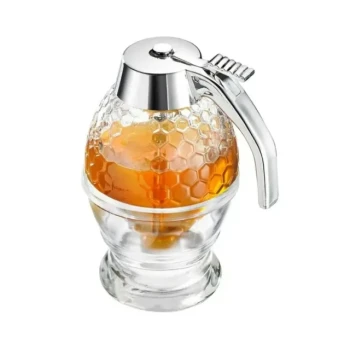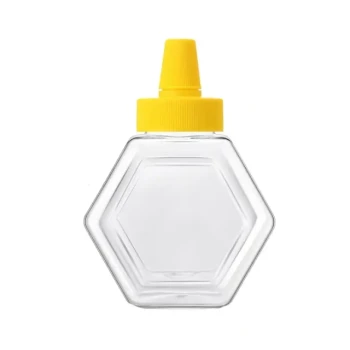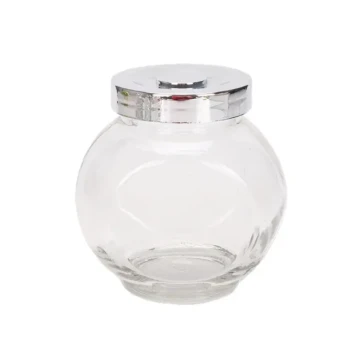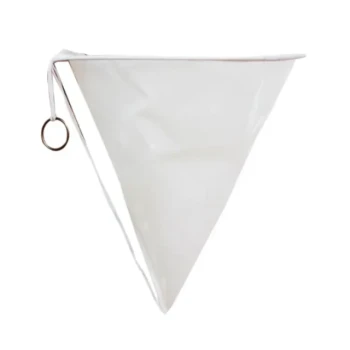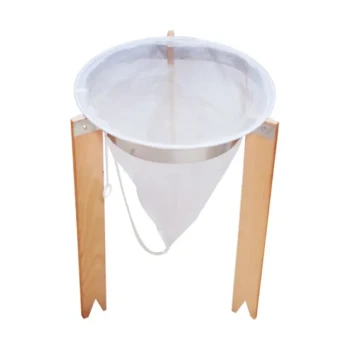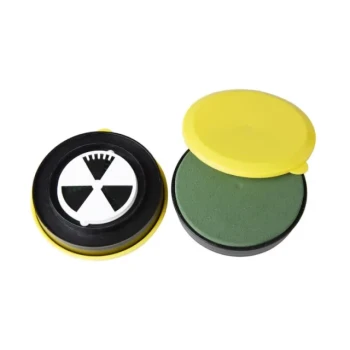Yes, you can safely store honey in a stainless steel container, provided it is specifically designated as food-grade. This practice is common in the commercial honey industry for large-scale storage because food-grade stainless steel is non-reactive, durable, and protects honey from degradation. The key is ensuring the material is appropriate for food contact.
The question is not about metal versus glass, but about the properties of the container material. The ideal storage for honey is any container that is non-reactive, airtight, and protects the contents from light and moisture, a standard that food-grade stainless steel meets exceptionally well.
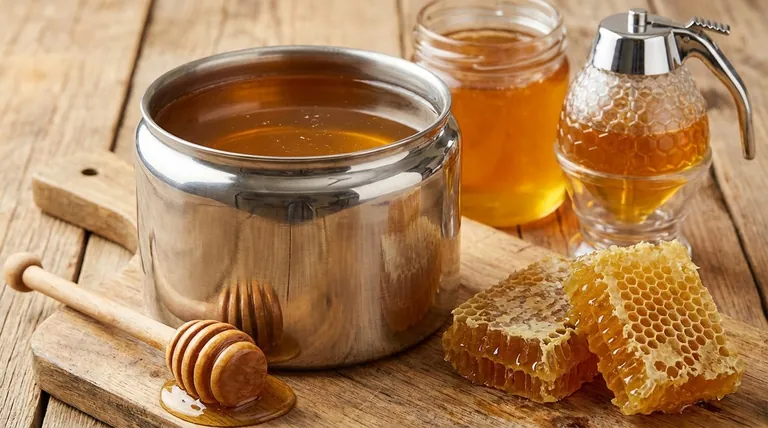
Why Stainless Steel is an Excellent Choice for Honey
Honey is a complex substance. It's naturally acidic and hygroscopic, meaning it readily absorbs moisture from the air. These properties dictate the requirements for proper storage.
It's a Non-Reactive Material
Honey has a low pH, typically between 3.4 and 6.1, making it acidic. Storing it in the wrong type of metal container can cause a chemical reaction.
Food-grade stainless steel (like types 304 or 316) is specifically engineered to be resistant to rust, corrosion, and oxidation, even when in contact with acidic foods. It will not leach metals or impart a metallic taste into the honey.
It's Impermeable and Durable
Unlike some plastics, stainless steel is completely non-porous. It provides an absolute barrier against air and moisture, which is critical for preventing fermentation.
Its durability also means it's less prone to cracks or damage, ensuring the integrity of the seal over long periods.
It Blocks Light
One of the primary recommendations for honey storage is to keep it in a dark place. Exposure to light can degrade the enzymes and antioxidants in honey over time.
An opaque stainless steel container offers complete protection from light, surpassing even dark-colored glass in this regard. This makes it ideal for preserving the honey's quality during long-term storage.
Understanding the Trade-offs and Critical Requirements
While stainless steel is a superior option, two factors are non-negotiable for ensuring the safety and quality of your honey.
The 'Food-Grade' Distinction is Essential
Not all stainless steel is created equal. Using a non-food-grade metal container is dangerous, as it can corrode from the honey's acidity, leaching harmful substances like chromium or nickel into the product.
Always confirm that your container is explicitly certified for food contact. This is the single most important factor for safety.
The Lid is as Important as the Container
Honey's ability to absorb moisture means that an improper seal can lead to fermentation. If the honey's water content rises above approximately 18%, dormant yeast spores can activate.
Ensure your stainless steel container has a tight-fitting, airtight lid. This prevents moisture absorption and protects the honey from airborne contaminants.
Glass vs. Stainless Steel
Glass is also an excellent, inert material for storing honey and is often preferred for retail packaging because it allows the consumer to see the product.
However, for bulk or long-term storage where light protection and durability are paramount, stainless steel is often the superior technical choice.
Making the Right Choice for Your Storage Needs
Your ideal container depends on your specific goal.
- If your primary focus is long-term bulk storage or maximum protection: Choose a certified food-grade stainless steel container with an airtight lid.
- If your primary focus is everyday kitchen use and visual appeal: A glass jar with a tight-fitting lid is an excellent and traditional choice.
- If your primary focus is absolute safety: The material must be certified food-grade, regardless of whether you choose stainless steel, glass, or a suitable plastic.
Ultimately, choosing a non-reactive, airtight, and light-blocking container will ensure your honey remains safe and delicious for years to come.
Summary Table:
| Feature | Benefit for Honey Storage |
|---|---|
| Non-Reactive (Food-Grade) | Prevents metallic taste and leaching; safe for acidic honey. |
| Impermeable & Airtight | Blocks air and moisture, preventing fermentation. |
| Light-Blocking | Protects enzymes and antioxidants from degradation. |
| Durable | Ideal for bulk, commercial, or long-term storage. |
Ready to scale your honey storage with professional equipment?
As a leading wholesale supplier to commercial apiaries and distributors, HONESTBEE provides durable, food-grade stainless steel containers and a full range of beekeeping supplies designed for high-volume operations. Ensure the quality and safety of your product from hive to market.
Contact our expert team today to discuss bulk pricing and find the perfect storage solutions for your business.
Visual Guide
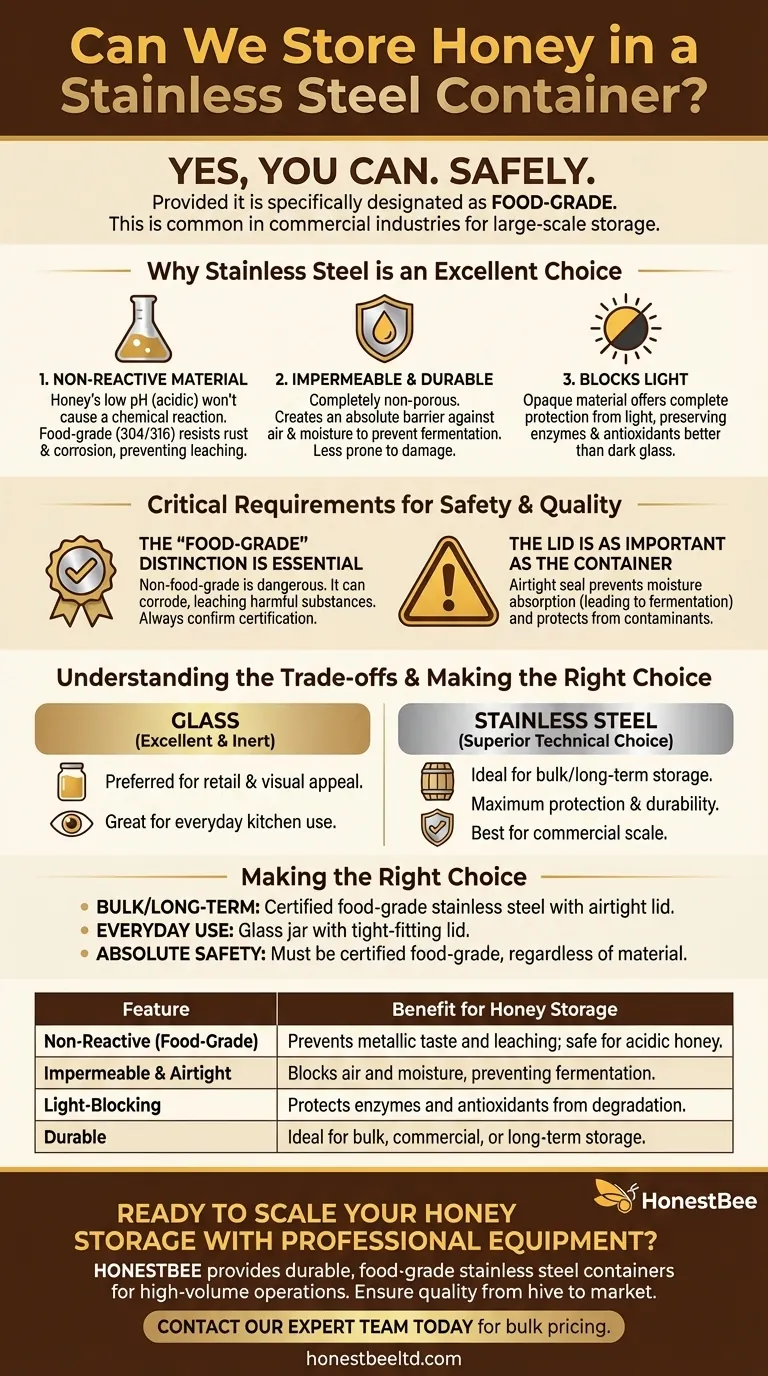
Related Products
- Honeycomb Style Drip Free Honey Dispenser
- Premium Diamond-Faceted Glass Honey Dispenser
- Hexagonal Squeeze Honey Bottle with No Drip Lid
- Inverted Squeezable Honey Jar with No Drip Flip Top Cap for Easy Pouring
- Classic Drum Shaped Glass Honey Jar with Airtight Lid
People Also Ask
- What is a honey taking spoon called? Discover the Tool for a Perfect, Mess-Free Drizzle
- What are the advantages of using a honey gate? Achieve Clean, Efficient Honey Bottling
- What is the purpose of a honey bowl and dipper setup? Achieve Mess-Free, Elegant Honey Dispensing
- How do you adjust the flow of honey using a honey gate valve? Master Precision Control for Your Bottling Line
- Can a honey gate be reused, and how should it be stored? Ensure Longevity for Your Honey Harvests
